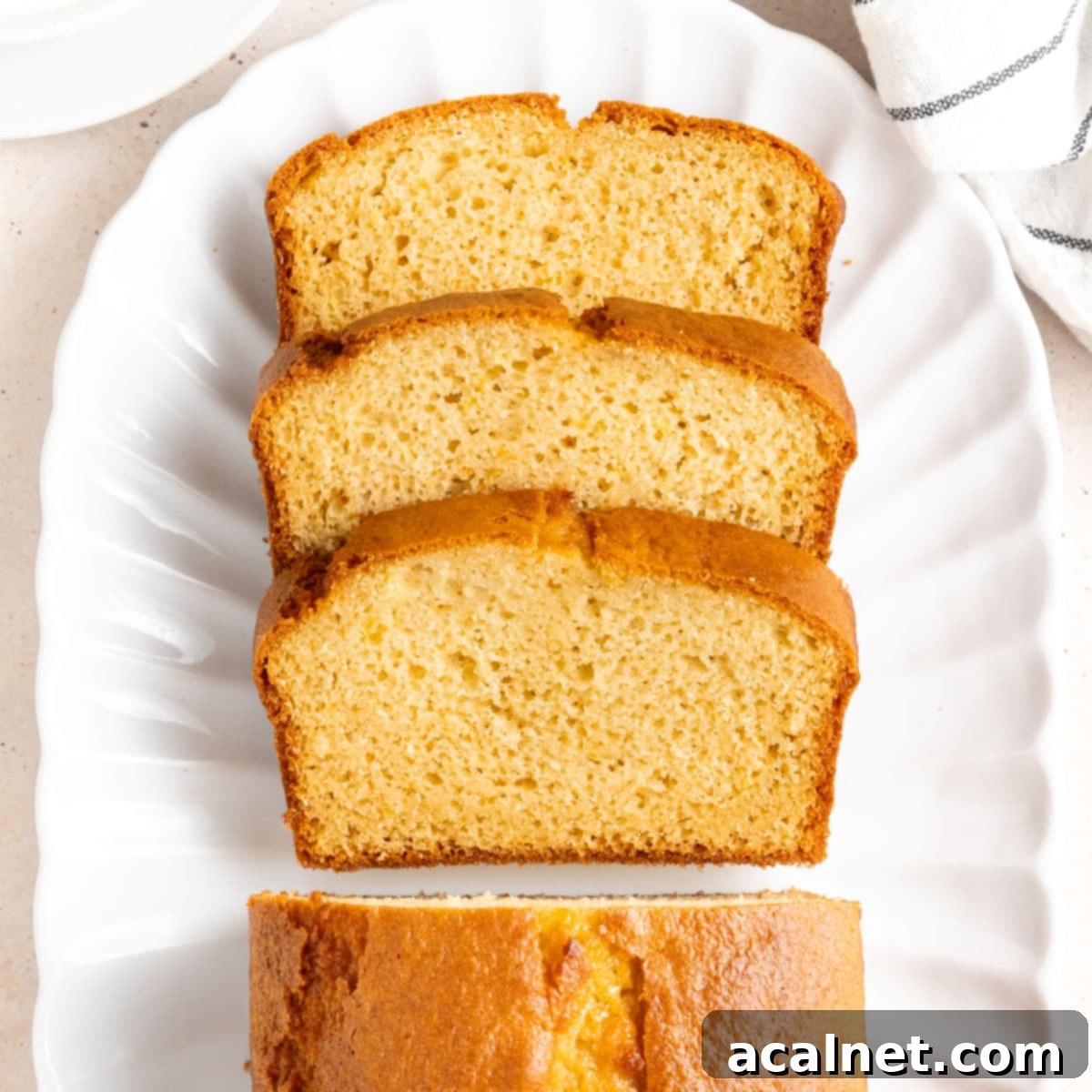Classic French Yogurt Cake (Gâteau au Yaourt): An Effortlessly Moist and Flavorful Delight
Step into the heart of French home baking with this traditional French Yogurt Cake, lovingly known as “Gâteau au Yaourt“. This isn’t just any cake recipe; it’s a cherished classic, renowned for being one of the absolute quickest and easiest desserts to whip up, perfect for bakers of all skill levels. With its incredibly rich flavor profile and a crumb that’s both tender and wonderfully moist, this cake transforms simple ingredients into an irresistible treat. It’s the ultimate comfort food, a delightful centerpiece for afternoon tea, or a perfect casual dessert for any day of the week.
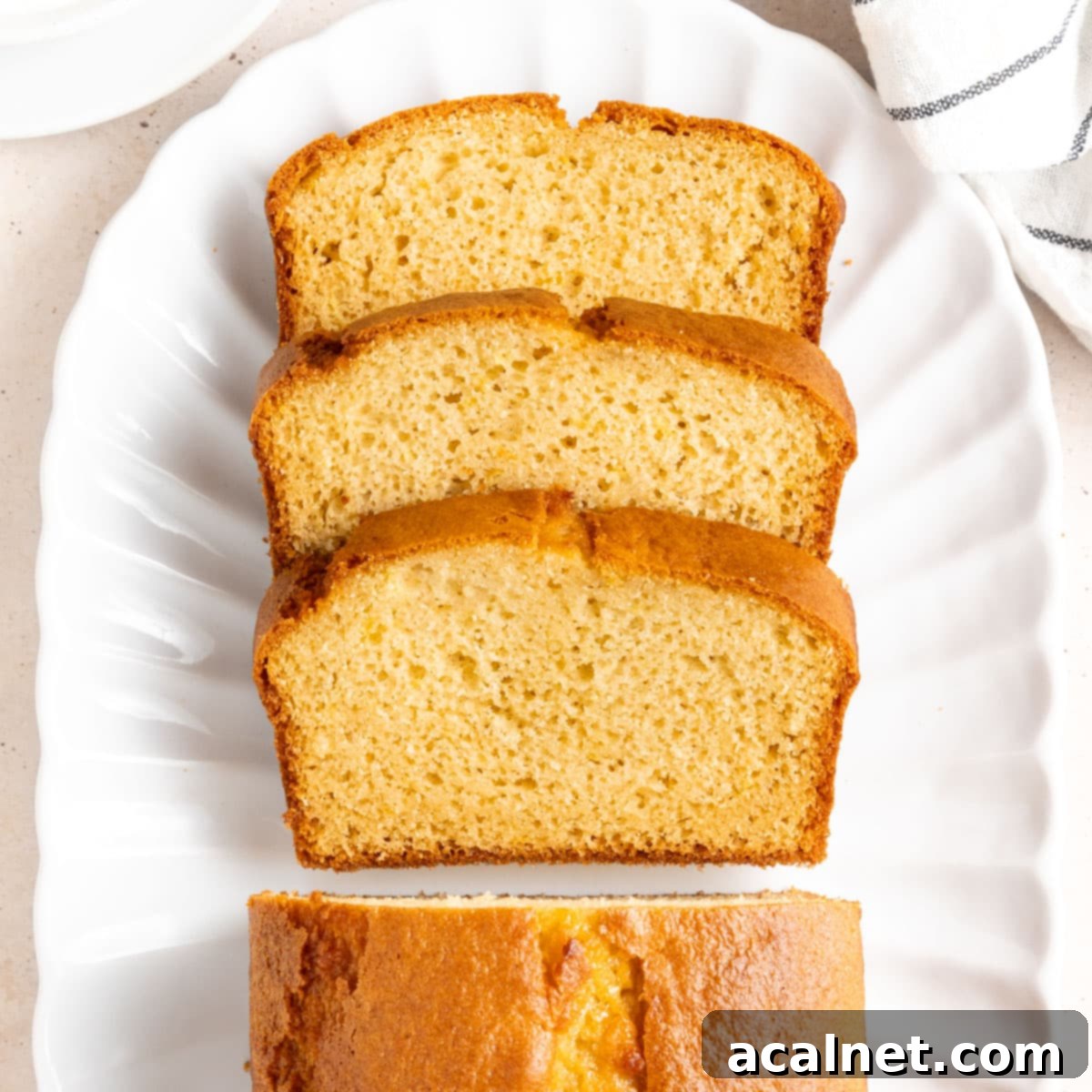
Why You’ll Fall in Love with This Easy French Yogurt Cake
There’s a reason why the French “Gâteau au Yaourt” holds a special place in the hearts of many, often referred to as the ultimate “gâteau de grand-mère” (grandma’s cake). Its enduring popularity stems from its incredible simplicity and the heartwarming, familiar taste it delivers every time. This humble cake comes together with just a handful of pantry staples and requires minimal effort, often ready to be popped into the oven within mere minutes of starting. It truly embodies the spirit of uncomplicated, joyful baking.
This classic French dessert is a weekend baking tradition in many French households, or a go-to when a quick and satisfying sweet treat is desired. What makes the traditional French yogurt cake recipe truly unique and accessible is its ingenious measurement system. Forget scales or elaborate measuring cups; this recipe famously uses an empty yogurt pot (yes, the very one you just emptied!) as the standard unit for all ingredients. This charming method not only simplifies the baking process but also adds a nostalgic touch, reminding many of childhood kitchen adventures, making it perfect for kids and beginner bakers alike.
Despite being a one-bowl wonder that uses just a few ingredients and a whisk, the result is consistently superb: a dessert that is deliciously flavorful, wonderfully soft, and incredibly moist. The yogurt works magic, imparting a tender crumb and a subtle tang that elevates the cake beyond its humble origins. It’s proof that sometimes, the simplest recipes yield the most delightful outcomes, cementing its status as a timeless French staple.
Eager for more delightful yogurt cake recipes? Be sure to explore these favorites: Scrumptious Yogurt Plum Cake | Bright & Zesty Lemon Yogurt Cake.
Essential Ingredients for Your Gâteau au Yaourt
Creating this delightful French Yogurt Cake requires only a few accessible ingredients, most of which you likely already have in your kitchen. The magic lies in the quality of these components and how they come together to create a harmonious flavor and texture. Choosing the right ingredients is the first step to ensuring your cake turns out perfectly moist and delicious.
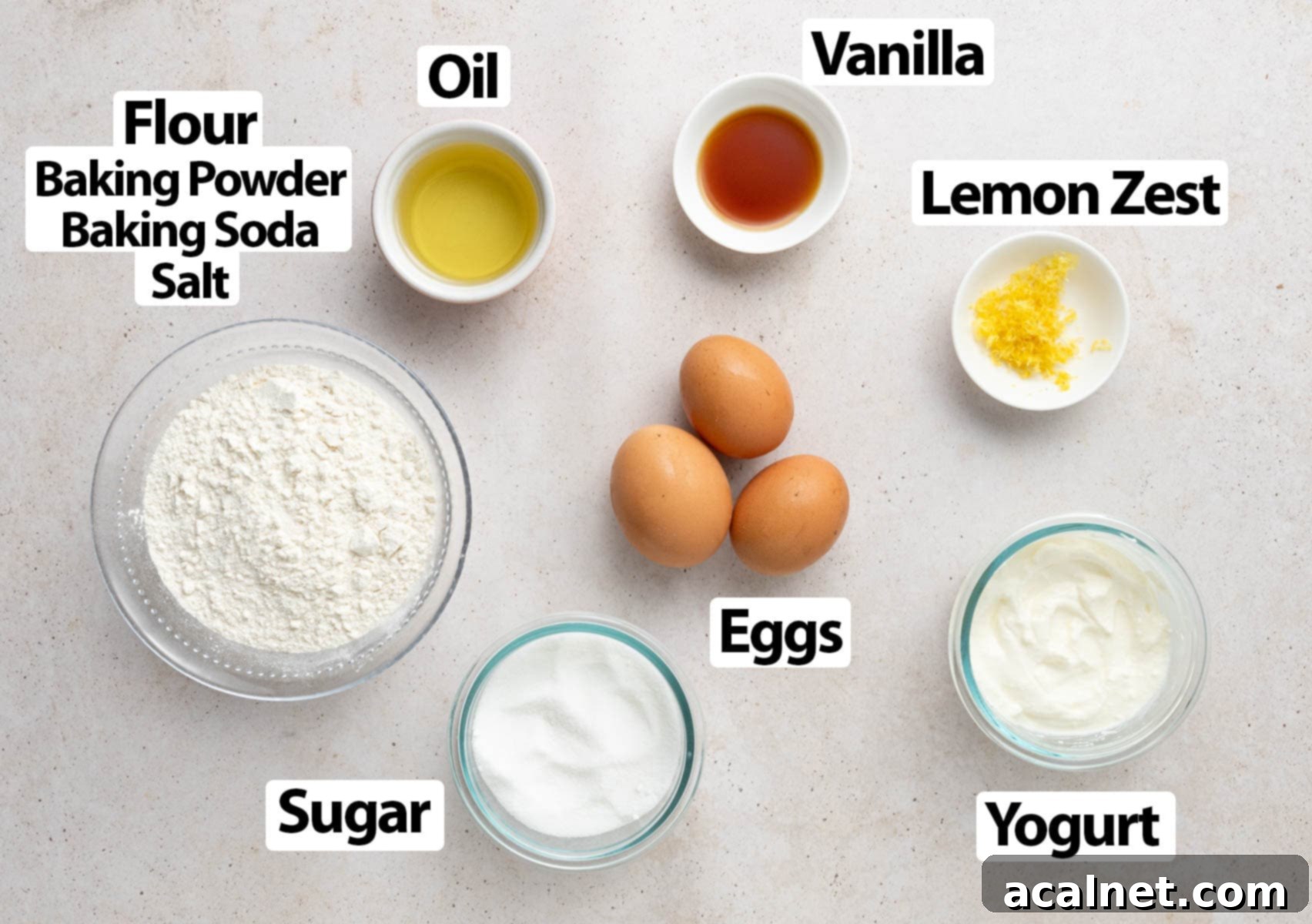
For precise quantities and measurements, please refer to the comprehensive recipe card located further down this page.
Here’s a closer look at what goes into this delicious French Yogurt Cake:
- Yogurt: The star of the show! Use natural, plain, full-fat yogurt for the absolute best results. Full-fat yogurt contributes significantly to the cake’s moistness and rich texture, something fat-reduced or light yogurts simply cannot replicate. While traditional recipes often specify plain yogurt, Greek yogurt is a fantastic alternative, yielding a slightly denser and even more tender crumb. Just ensure it’s full-fat for that classic Gâteau au Yaourt goodness.
- Eggs: Large eggs, brought to room temperature, are crucial for a well-emulsified batter and a light, even crumb. Room temperature eggs combine more easily with other ingredients, preventing a lumpy batter and promoting better rise in your cake.
- Sugar: Caster sugar or fine white granulated sugar is ideal here. Its fine crystals dissolve quickly, ensuring a smooth batter and a perfectly sweet, delicate cake without any grainy texture.
- Vanilla Extract: While optional, a good quality vanilla extract dramatically enhances the cake’s aroma and depth of flavor. It adds a warm, comforting note that complements the tang of the yogurt beautifully. Don’t skip it if you want to elevate your cake and give it that quintessential home-baked scent.
- Lemon Zest: Highly recommended! The bright, fragrant zest of a fresh lemon provides a wonderful counterpoint to the richness of the cake. It adds a subtle ‘zing’ and a fresh aroma that pairs perfectly with the yogurt, giving the cake a truly authentic French touch. Grate it finely to release maximum flavor and distribute it evenly throughout the batter.
- Oil: Unlike many traditional European cakes that rely on butter, the Gâteau au Yaourt is typically made with neutral-flavored oil. This choice contributes to the cake’s incredibly moist texture and lighter crumb, making it less dense than butter-based cakes. Canola oil (which I used), sunflower oil, grapeseed oil, or any other neutral vegetable oil will work perfectly. The key is a neutral flavor that won’t overpower the delicate notes of yogurt and lemon.
- Dry Ingredients: This blend consists of plain / all-purpose flour, baking powder, baking soda, and a pinch of salt. The baking powder and soda provide the necessary lift and aeration, resulting in a tender texture, while salt balances the sweetness and enhances all the other flavors, making them pop. If you prefer to use self-rising flour, simply substitute it for the plain flour and omit the baking powder and baking soda, though I’d still recommend adding a small pinch of salt to round out the taste.
Delightful Variations & Customization Ideas for Your Yogurt Cake
The beauty of such a simple cake lies in its incredible versatility. The French Yogurt Cake serves as an excellent blank canvas, inviting you to experiment and create more complex, yet equally delicious, desserts. Whether you’re looking to add a fruity twist, a decadent chocolate touch, or a sophisticated aroma, here are a few inspiring ideas to customize your yogurt loaf and make it uniquely yours:
- **Citrus Swap**: While lemon zest is a classic and highly recommended, feel free to replace it with other vibrant citrus zests for a different flavor profile. Imagine the fragrant notes of orange zest for a sweeter, sunnier cake, or the sharp, refreshing tang of lime zest for a more exotic, tropical twist.
- **Chocolate Lover’s Dream**: For those who adore chocolate, this cake is a perfect vehicle. Consider folding in a handful of chocolate chips (dark, milk, or white!) into the batter just before baking. Alternatively, once the cake has cooled, drizzle it generously with a luxurious, homemade chocolate ganache for an elegant and decadent finish.
- **Fresh Fruit Infusion**: Incorporate seasonal fresh berries (like raspberries, blueberries, or chopped strawberries) directly into the cake batter. To prevent these juicy gems from sinking to the bottom during baking, lightly toss them in a tablespoon of flour before gently folding them into the mixture. This ensures an even distribution of fruit throughout your cake.
- **Aromatic Extracts**: Beyond vanilla, explore other delightful extracts and floral waters to perfume your cake with unique aromas. A dash of almond extract adds a nutty depth, while rosewater extract or delicate orange blossom water lends an enchanting, subtle floral aroma, popular in many traditional French pastries.
- **Layered & Filled**: Transform your humble loaf into a showstopper by slicing the cooled cake horizontally into two or three layers. Fill it with your favorite fruit jam, luscious Chantilly cream, homemade fruit compote, or fresh sliced fruits for an impressive, yet still surprisingly easy, dessert that’s perfect for special occasions.
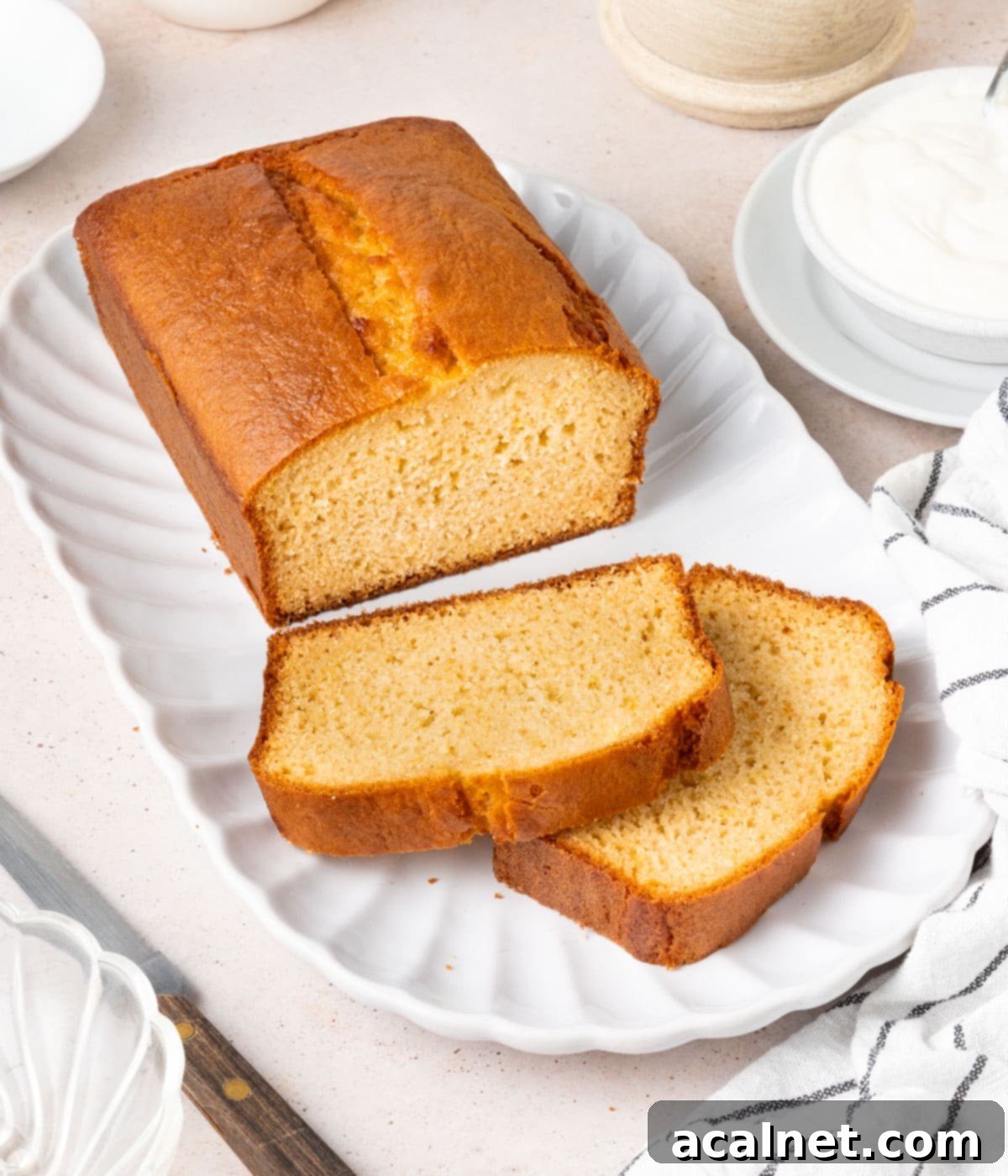
Understanding the Traditional French Yogurt Cake Ratios (The Yogurt Pot Method)
The charm and simplicity of the Gâteau au Yaourt truly shine through its unique measurement system. As mentioned earlier, the traditional recipe famously foregoes scales and standard measuring cups, instead relying on an empty yogurt pot (or jar/container) as the universal measuring tool for all ingredients. This method isn’t just a quaint tradition; it’s a brilliant way to make baking accessible and fuss-free, particularly for children or novice bakers. It’s a testament to French culinary ingenuity, proving that delicious results don’t always require precise scientific measurements.
The standard ratios, using one yogurt pot as the base unit, are as follows:
- 1 pot of yogurt (this is your starting point and measuring vessel for all other ingredients)
- 3 eggs (typically large eggs, at room temperature for best results)
- 2 pots of sugar (for a traditional, sweeter cake, though easily adjustable)
- 1/2 pot of neutral oil (for that signature moist crumb)
- 3 pots of all-purpose flour (the main structural component)
- 1 1/2 teaspoons of baking powder (the primary leavening agent)
- Optionally, some vanilla extract and/or lemon zest for enhanced flavor.
To implement this ingenious method, you simply empty one pot of yogurt into your mixing bowl. Then, rinse and thoroughly dry that very same yogurt pot and use it to scoop and measure all the remaining ingredients. This eliminates the need for any other measuring tools, making clean-up a breeze and the entire process incredibly intuitive, embracing a more relaxed approach to baking.
In France, a standard individual yogurt pot usually equates to approximately 120 ml (or about 1/2 cup / 4 oz). This means even if you don’t have a specific “French” yogurt jar, you can easily replicate this method using a standard 1/2 cup measuring cup as your base unit for all ingredients. This makes the recipe universally adaptable and perfect for bakers around the world!
For this specific recipe, I’ve opted to slightly reduce the sugar from the traditional 2 yogurt pots to 1 1/2 pots. This adjustment results in a cake that is still perfectly sweet but allows the delicate flavors of the yogurt and lemon to shine through more prominently, appealing to modern palates that prefer a less intensely sweet dessert. If you prefer an even less sweet dessert, you could comfortably reduce the sugar further, down to just 1 pot, without compromising the cake’s structure or moistness.
How to Bake Your Perfect French Yogurt Cake: A Step-by-Step Guide
Baking this Gâteau au Yaourt is a straightforward process, ideal for a relaxed afternoon activity or a quick weeknight treat. Following these simple steps will guide you to create a beautifully moist and flavorful cake with ease. Remember that careful preparation and gentle mixing are key to its success.
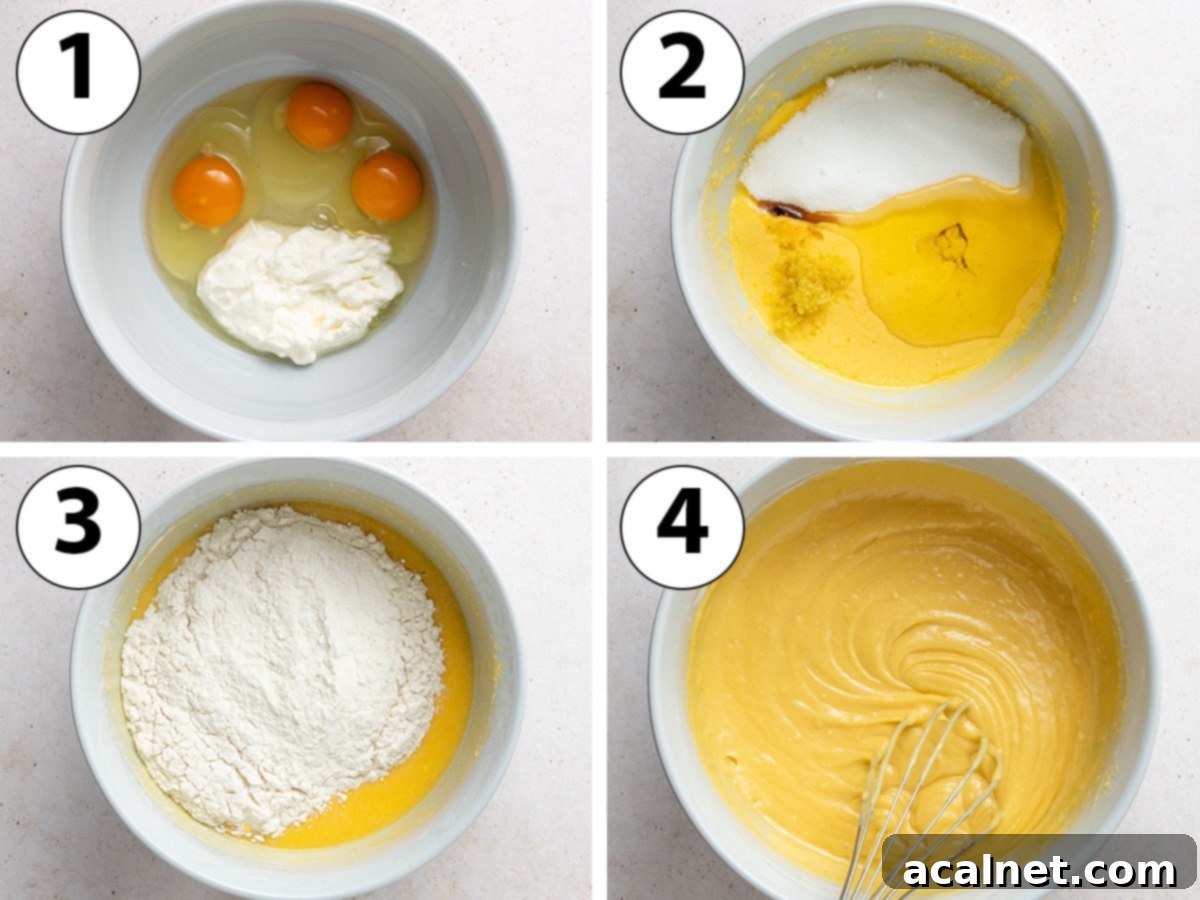
- 1. Preparation is Key: Begin by preheating your oven to 180℃ / 350 ℉. Next, lightly grease a 12 x 22 cm (5 x 9 inch) loaf pan. For easy removal and to prevent sticking, line the bottom of the pan with a strip of baking paper, allowing it to overhang slightly for easy lifting. A quick spray with cooking spray usually does the trick, but you can also use a paper towel to spread a thin layer of melted butter or neutral oil.
- 2. Photo 1: Whisk Wet Ingredients: In a generously sized mixing bowl, combine the room temperature eggs and the full-fat yogurt. Whisk them together thoroughly until the mixture is completely smooth and well-combined. This forms the luscious base of your cake batter, ensuring even moisture.
- 3. Photo 2: Incorporate Flavor Enhancers: To the egg and yogurt mixture, add the caster sugar, neutral oil, vanilla extract (if using), and fresh lemon zest (highly recommended!). Continue to whisk vigorously until all these ingredients are perfectly incorporated, creating a homogenous, slightly pale batter. This ensures all the flavors are evenly distributed.
- 4. Photo 3: Add Dry Ingredients: Carefully sift all the dry ingredients – the plain / all-purpose flour, baking powder, baking soda, and a pinch of fine table salt – directly into the wet mixture. Sifting helps to aerate the flour and prevent lumps, ensuring a smooth batter. Mix until no streaks of flour remain, but be very careful to avoid over-mixing the batter. Over-mixing can develop the gluten in the flour too much, leading to a tough or dry cake. Stop mixing as soon as everything is just combined.
- 5. Photo 4: Bake to Perfection: Gently pour the prepared cake batter into your greased and lined loaf pan. Use a spatula to scrape out all the batter from the bowl. Transfer the pan to your preheated oven and bake for approximately 35 to 40 minutes. The cake is done when a wooden toothpick or a cake tester inserted into the center comes out clean, indicating it’s cooked through.
- 6. Cooling Down: Once baked, remove the cake from the oven and immediately place it on a wire rack. Allow the cake to cool down completely in the pan before attempting to slice or remove it. This crucial step allows the cake to set properly, prevents it from crumbling when handled, and locks in all that wonderful moisture. Patience is a virtue here!
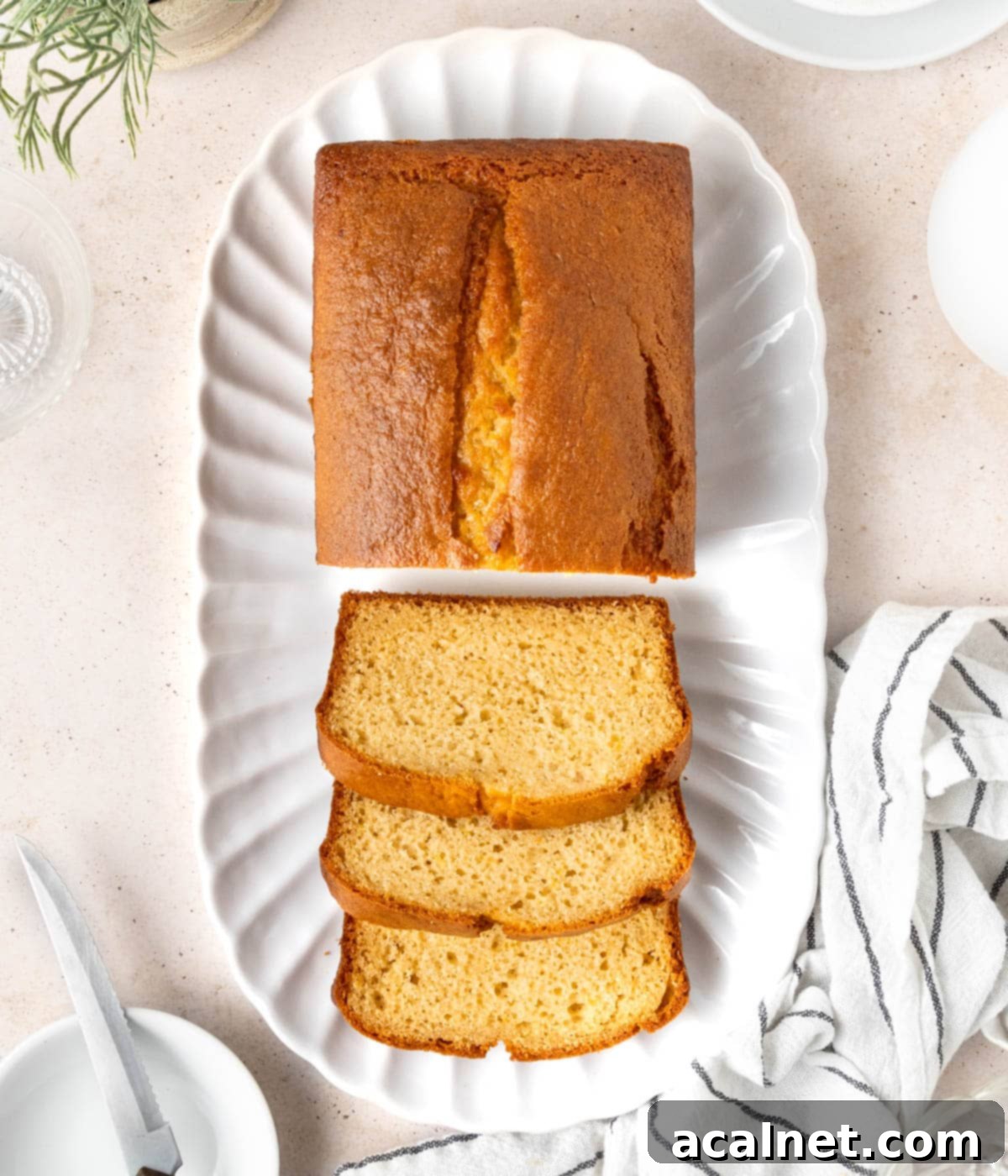
Frequently Asked Questions About Gâteau au Yaourt
For the most authentic flavor and incredibly moist texture, always opt for a full-fat plain yogurt (also known as natural yogurt). The higher fat content contributes significantly to the cake’s richness and tender crumb. I’ve personally made this recipe numerous times with full-fat Greek yogurt, and it yields equally fantastic results, often a slightly denser and more luxurious cake. The critical point is to avoid fat-reduced or “light” yogurts, as they will make your cake dry and compromise its texture. If you’re looking to make this recipe dairy-free, you can substitute with a full-fat dairy-free yogurt. However, be aware that alternative yogurts like coconut yogurt will impart their unique flavor to the cake, so choose one that complements your desired taste.
Absolutely, you can! The combination of all-purpose flour, baking powder, and baking soda can be conveniently substituted with self-rising flour. Simply use the same quantity of self-rising flour as you would for the all-purpose flour in the recipe. The leavening agents are already pre-mixed into self-rising flour, making the process even simpler. While not strictly necessary, adding a small pinch of salt is still recommended, as it helps to balance the sweetness and enhance the overall flavor profile of your cake, much like a chef would season a dish.
Yes, this versatile cake batter adapts well to different pan shapes. I frequently bake this French Yogurt Cake in an 8-inch (20cm) round springform pan, and it turns out just as magnificent, often with a slightly more elegant presentation. When using a round pan, you might notice that the cake bakes a little bit more quickly than in a loaf pan due to the difference in surface area and depth. I recommend checking for doneness a bit earlier, usually reducing the baking time by about 5 to 10 minutes. Always use the toothpick test to ensure it’s perfectly baked through. You can also use muffin tins for individual servings, reducing the baking time significantly to around 18-22 minutes, perfect for parties or lunchboxes.
A dry Gâteau au Yaourt is usually a result of one of two common mistakes: either you’ve used low-fat or fat-reduced yogurt (which lacks the crucial moisture-rich fats), or the cake batter was over-mixed. Over-mixing develops the gluten in the flour too much, making the cake tough and dry. To avoid this, always use full-fat yogurt and mix the dry ingredients into the wet ones just until they are combined and no streaks of flour remain – stop immediately after, even if a few small lumps persist. Another factor could be over-baking, so keep a close eye on your oven and test for doneness at the earliest recommended time.
For that signature golden, slightly crackled crust that makes the Gâteau au Yaourt so appealing, ensure your oven is preheated correctly and your cake is baked for the full recommended time. Some traditional recipes suggest a simple trick: lightly brush the top of the cake with a little milk or sprinkle with a tiny bit of coarse sugar just before baking. This encourages browning and a lovely sparkle. Another tip for a rustic look is to cut a shallow line down the center of the batter once it’s in the pan; this helps it crack evenly and creates a charming, homemade appearance as it bakes.
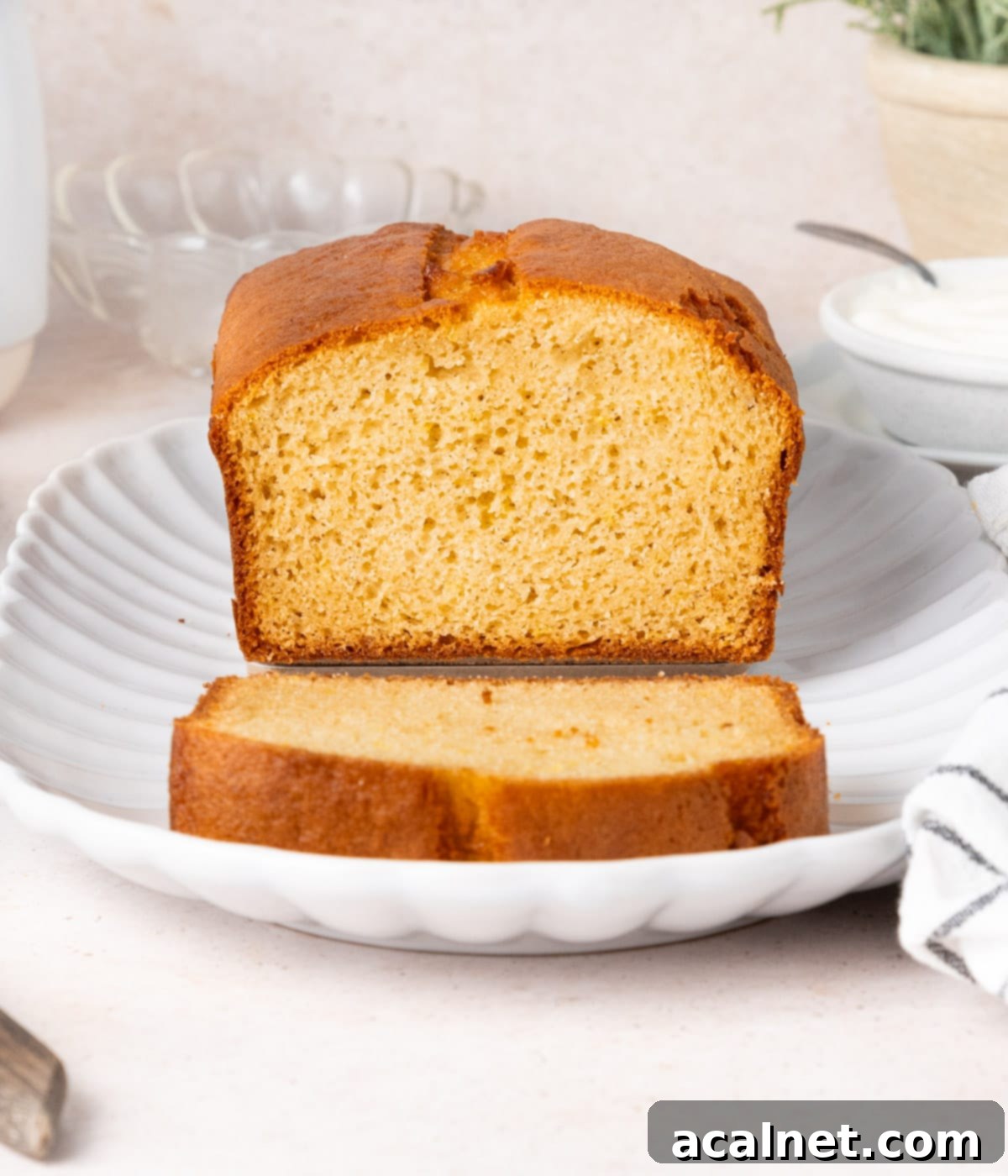
Elevate Your Gâteau au Yaourt: Delicious Serving Suggestions
While the French Yogurt Cake is undeniably delightful on its own, its simple, comforting flavor profile makes it an ideal base for a variety of accompaniments. Whether you prefer a touch of extra sweetness, a burst of fruitiness, or a creamy indulgence, there are countless ways to enhance your Gâteau au Yaourt experience, transforming it from a simple treat into a memorable dessert.
- Simple Glaze Perfection: For a quick and elegant finish, drizzle the cooled cake with a simple glaze. A classic option is a powdered sugar (confectioners’ sugar) glaze, made by whisking powdered sugar with a splash of milk or water until smooth. For an extra tang that beautifully complements the cake’s lemon notes, create a bright lemon glaze using powdered sugar and fresh lemon juice. This adds a lovely sheen and a burst of flavor.
- Creamy Indulgences: Pair a slice of this moist cake with a dollop of something creamy for a luxurious texture contrast. Traditional French choices include rich Crème Fraiche, airy whipped cream, or the indulgent Chantilly cream. For a warmer, more sophisticated pairing, a velvety Crème Anglaise (custard sauce) is exquisite. And of course, a scoop of good quality vanilla ice cream is always a crowd-pleaser, especially when the cake is served slightly warm! Fresh berries served alongside any of these creamy options add a burst of freshness and color.
- Frosting & Toppings: Feel free to crown your yogurt loaf with your favorite frosting, though a lighter touch often works best to let the cake’s natural flavor shine through. A delicate whipped ganache adds richness without being overly heavy. For a vibrant, tangy topping, a homemade lemon curd is a fantastic choice, providing a sweet-tart contrast. Alternatively, simply serve it with an extra dollop of fresh yogurt for a healthier option that highlights the cake’s key ingredient.
- Fruity Coulis & Compotes: Fruit coulis and compotes are a truly delicious way to finish this yogurt cake, adding both moisture and intense fruit flavor. Their vibrant colors and fresh tastes make any slice more appealing. I often enjoy serving this cake with a homemade Peach Compote, but the possibilities are endless depending on seasonal availability and personal preference. Consider a vibrant Mixed Berry Compote, a sweet Cherry Compote, a bright Strawberry Coulis, an exotic Passion Fruit Coulis, a tart Raspberry Compote, or a classic Stewed Rhubarb. Each offers a unique flavor profile that complements the Gâteau au Yaourt beautifully.
Storing and Freezing Your French Yogurt Cake for Lasting Freshness
One of the many convenient aspects of the French Yogurt Cake is how well it stores, allowing you to enjoy its fresh taste for days or even save slices for a future craving. Proper storage ensures its signature moistness remains intact and that every bite is as delightful as the first.
This delightful cake can be kept at room temperature for a good 2 to 3 days. To maintain its freshness and prevent it from drying out, it’s essential to store it in an airtight container or ensure it’s tightly wrapped with plastic wrap or aluminum foil. While it might be tempting to refrigerate it, doing so can actually accelerate the drying process of the crumb, making it less enjoyable due to the cold air. Only refrigerate if your kitchen is exceptionally warm, or if you’ve added fresh cream or fruit toppings that absolutely require chilling for food safety.
For longer-term enjoyment, the French Yogurt Cake also freezes exceptionally well. You can freeze it either as a whole loaf or, for ultimate convenience, pre-slice it before freezing. To freeze, ensure the cake is completely cooled. Then, wrap the cake (or individual slices) tightly in plastic wrap, followed by a layer of aluminum foil, or place it in a freezer-safe bag. This double-layer protection helps prevent freezer burn. When you’re ready to enjoy it again, simply leave it at room temperature for a few hours to thaw. For an overnight thaw, transfer it to the refrigerator. Once thawed, it will taste almost as fresh as the day it was baked, making it perfect for meal prepping desserts or having a spontaneous treat ready to go whenever a craving strikes.
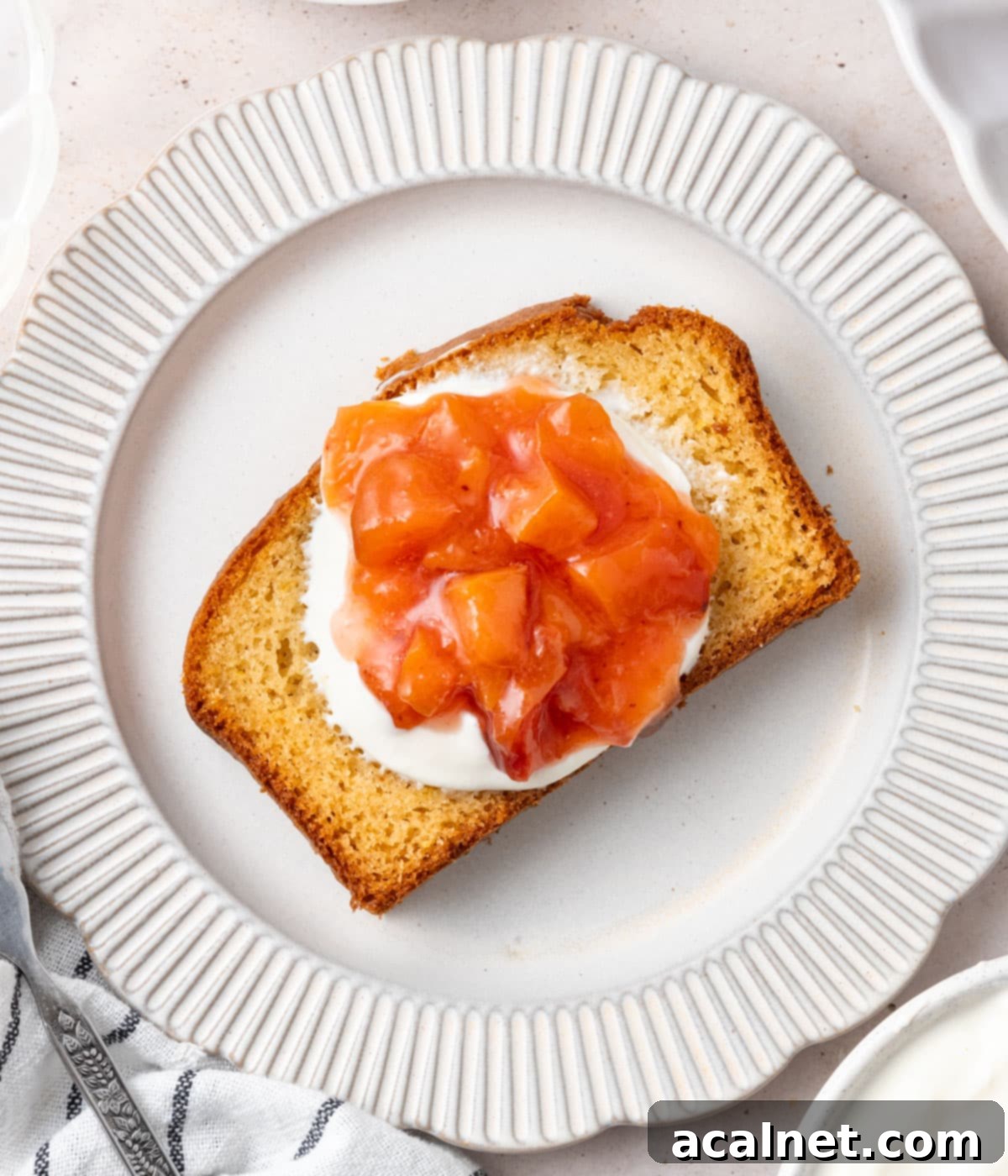
Explore More Easy Cake Recipes
If you’ve enjoyed the simplicity and deliciousness of this French Yogurt Cake, you’re in for a treat! Our collection features many more straightforward and delightful cake recipes perfect for any occasion. These recipes are designed to be approachable for bakers of all levels, ensuring a rewarding and tasty experience every time:
- Decadent French Chocolate Fondant Cake
- Comforting Pear and Chocolate Cake
- Sweet Strawberry Upside-Down Cake
- Light and Zesty Lemon Ricotta Cake
- Fragrant Orange Loaf Cake
- Irresistible Easy Biscoff Cake
- Elegant Pistachio Raspberry Loaf Cake
I am so excited to share that my debut cookbook
“Bite-Sized French Pastries for the Beginner Baker”
is now available for purchase!

Recipe Card

Easy French Yogurt Cake (Gâteau au Yaourt)
Ingredients
- 120 gr Natural Plain Yogurt
- 3 large Eggs
- 150 gr Caster Sugar
- 60 ml Neutral Oil, such as canola oil
- 1 teaspoon Vanilla Extract, optional
- 1 1/2 teaspoon Lemon Zest (from 1 large lemon), optional
- 225 gr Plain / All-Purpose Flour
- 1 1/2 teaspoon Baking Powder
- 1/2 teaspoon Baking Soda
- 1 pinch Fine Table Salt
Instructions
- Preheat your oven to 180℃ / 350 ℉. Lightly grease a 12 x 22 cm (5 x 9 inch) loaf pan and line the bottom with a piece of baking paper.
- In a large bowl, whisk together the eggs and yogurt until smooth. Add the sugar, oil, vanilla and lemon zest. Whisk until combined.
- Sift in the flour, baking powder, baking soda and salt. Whisk until no lumps remain, stopping as soon as combined to avoid over-mixing the batter.
- Pour the cake batter into the prepared pan and bake for 35 to 40 minutes, or until a skewer comes out clean.
- Place on a wire rack and let the cake cool down completely before slicing or removing from the pan.
Would you like to save this recipe?
We’ll email this post to you, so you can come back to it later!
Notes
- 1 pot yogurt
- 3 eggs
- 1 1/2 to 2 pots sugar
- 1/2 pot oil
- optional: 1 1/2 teaspoon lemon zest and/or 1 teaspoon vanilla extract
- 3 Pots Flour
- 1 1/2 teaspoon baking powder + 1/2 teaspoon baking soda + pinch salt
Nutrition (per serving)
Made this recipe?
We’d love to hear from you! Let us know if you liked it by leaving a comment below, and don’t forget to tag us on Instagram @a.baking.journey with a photo of your delicious creation!
